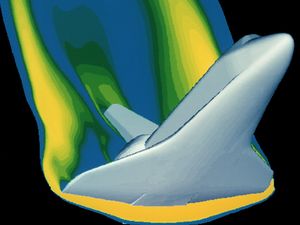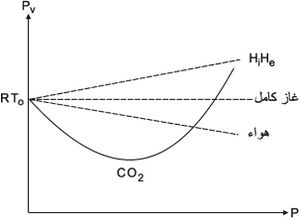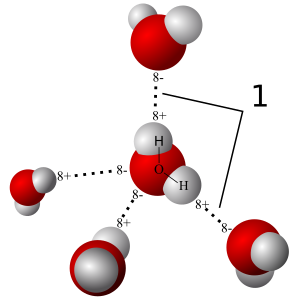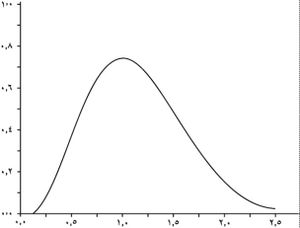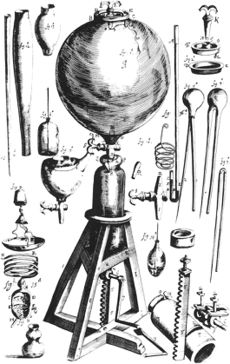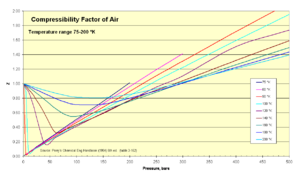غاز
| جزء من سلسلة عن |
| ميكانيكا الاستمرارية |
|---|
الغاز هو أحد حالات المادة ، و مثل السوائل فإن الغازات موائع أى أن لها قابلية للسريان ولا تقاوم تغيير شكلها ، بالرغم من أن لها لزوجة . وعلى غير ما يحدث في السوائل ، فإن الغازات الحرة لا تشغل حجم ثابت ولكنها تملأ أى فراغ تشغله . وطاقة حركة الغازات هى ثاني أهم حالات المادة ( بعد البلازما . ونظرا لزيادة طاقة حركة الغازات فإن جزيئات وذرات الغازات تميل لأن تتعدى أى سطح يحتويها ، ويزداد هذا بزيادة طاقة الحركة . ويوجد مفهوم خاطئ يتعلق بأن اصطدام الجزيئات ببعضها ضروري لمعرفة ضغط الغاز ، ولكن الحقيقة أن سرعاتها العشوائية كافية لتحديد كمياتها . الإصطدامات بين الجزيئات مهمة فقط للحصول على توزيع ماكسويل-بولتزمان .
تتفرق جسيمات الغاز بطريقة معاكسة لجسيمات السوائل ، التى تتلامس . فجسيم مادى مثلا ذرة غبار) في الغازات تتحرك في حركة براونية . وحيث أنه لا توجد تقنية حالية تمكننا من ملاحظة حركة جسيم غازي محدد (ذرات أو جزيئات) ، فإن الحسابات النظرية فقط تعطى اقتراحات عن كيفية تحركهم ولكن حركتها تختلف عن الحركة البروانية . والسبب في هذا أن الحركة البروانية تتضمن انزلاق سلس تحت تأثير قوى الأحتكاك بين جزيئات الغاز بينما لها إصطدامات عنيفة بين جزيء أو جزيئات الغاز مع الجسيم . الجسيم (غالبا يتكون من مليارات المليارات من الذرات) يتحرك في أشكال حادة ، وحتى الآن لا يوجد حدة تم توقعها لو تم متابعة جزيء غازي محدد، أمثلة: ثاني أكسيد الكربون، الميثان، أكسيد النيتروز، سادس فلوريد الكبريت، الهالوكربونات.
The gaseous state of matter occurs between the liquid and plasma states,[1] the latter of which provides the upper temperature boundary for gases. Bounding the lower end of the temperature scale lie degenerative quantum gases[2] which are gaining increasing attention.[3] High-density atomic gases super-cooled to very low temperatures are classified by their statistical behavior as either Bose gases or Fermi gases. For a comprehensive listing of these exotic states of matter see قائمة حالات المادة.
الغازات العنصرية
The only chemical elements that are stable diatomic homonuclear molecules at STP are hydrogen (H2), nitrogen (N2), oxygen (O2), and two halogens: fluorine (F2) and chlorine (Cl2). When grouped together with the monatomic noble gases – helium (He), neon (Ne), argon (Ar), krypton (Kr), xenon (Xe), and radon (Rn) – these gases are called "elemental gases".
أصل الكلمة
قالب:Improve The word gas was first used by the early 17th-century Flemish chemist Jan Baptist van Helmont.[4] He identified carbon dioxide, the first known gas other than air.[5] Van Helmont's word appears to have been simply a phonetic transcription of the Ancient Greek word χάος Chaos – the g in Dutch being pronounced like ch in "loch" (voiceless velar fricative, /x/) – in which case Van Helmont was simply following the established alchemical usage first attested in the works of Paracelsus. According to Paracelsus's terminology, chaos meant something like "ultra-rarefied water".[6]
An alternative story[7] is that Van Helmont's word is corrupted from gahst (or geist), signifying a ghost or spirit. This was because certain gases suggested a supernatural origin, such as from their ability to cause death, extinguish flames, and to occur in "mines, bottom of wells, churchyards and other lonely places". In contrast, French-American historian Jacques Barzun[8] speculated that Van Helmont had borrowed the word from the German Gäscht, meaning the froth resulting from fermentation.
الخصائص الطبيعية
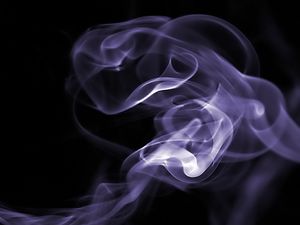
يطلق اسم الغاز على الأجسام التي توجد في حالة فيزيائية تتصف بمجموعة من الخواص، منها عدم وجود شكل وحجم خاصَّين بها، مما يميزها من الأجسام السائلة والصلبة.
تتكوَّن الغازات من جزيئات يمنعها الاضطراب الحراري من التجمع، إلاّ إذا كان الضغط كبيراً أو كانت درجة الحرارة منخفضة إلى حدٍ كافِ، حينئذٍ يتكاثف الغاز ليصبح سائلاً أو صلباً، وهكذا فإن كل الغازات المعروفة قابلة للتكاثف بسهولة تزيد أو تنقص. وعندما يتبخر سائل أو يتصعَّد جسم صلب، فإنه يتحول إلى بخار له خواص الغاز كلها.
تكون الغازات في الشروط المعتادة مادة في حالة مبعثرة، وتكون كتلتها الحجمية masse volumique أصغر بكثير من الأجسام في الحالة الكثيفة، الصلبة أو السائلة؛ فالكتلة الحجمية للهواء الجاف في درجة الحرارة 0ºC وتحت ضغط جوي واحد (الشروط النظامية) تساوي 1.2928غرام/ليتر، أي حوالي أصغر بنحو800 مرة من الكتلة الحجمية للماء في درجة الحرارة نفسها>
بالعين المجردة
When observing a gas, it is typical to specify a frame of reference or length scale. A larger length scale corresponds to a macroscopic or global point of view of the gas. This region (referred to as a volume) must be sufficient in size to contain a large sampling of gas particles. The resulting statistical analysis of this sample size produces the "average" behavior (i.e. velocity, temperature or pressure) of all the gas particles within the region. In contrast, a smaller length scale corresponds to a microscopic or particle point of view.
Macroscopically, the gas characteristics measured are either in terms of the gas particles themselves (velocity, pressure, or temperature) or their surroundings (volume). For example, Robert Boyle studied pneumatic chemistry for a small portion of his career. One of his experiments related the macroscopic properties of pressure and volume of a gas. His experiment used a J-tube manometer which looks like a test tube in the shape of the letter J. Boyle trapped an inert gas in the closed end of the test tube with a column of mercury, thereby making the number of particles and the temperature constant. He observed that when the pressure was increased in the gas, by adding more mercury to the column, the trapped gas' volume decreased (this is known as an inverse relationship). Furthermore, when Boyle multiplied the pressure and volume of each observation, the product was constant. This relationship held for every gas that Boyle observed leading to the law, (PV=k), named to honor his work in this field.
There are many mathematical tools available for analyzing gas properties. As gases are subjected to extreme conditions, these tools become more complex, from the Euler equations for inviscid flow to the Navier–Stokes equations[9] that fully account for viscous effects. These equations are adapted to the conditions of the gas system in question. Boyle's lab equipment allowed the use of algebra to obtain his analytical results. His results were possible because he was studying gases in relatively low pressure situations where they behaved in an "ideal" manner. These ideal relationships apply to safety calculations for a variety of flight conditions on the materials in use. The high technology equipment in use today was designed to help us safely explore the more exotic operating environments where the gases no longer behave in an "ideal" manner. This advanced math, including statistics and multivariable calculus, makes possible the solution to such complex dynamic situations as space vehicle reentry. An example is the analysis of the space shuttle reentry pictured to ensure the material properties under this loading condition are appropriate. In this flight regime, the gas is no longer behaving ideally.
الضغط
The symbol used to represent pressure in equations is "p" or "P" with SI units of pascals.
الغازات قابلة للانضغاط compressibles؛ لأن حجمها يتناقص عندما يزيد الضغط عليها، وقابلة للتوسُّع expansibles؛ لأنها تشغل دائماً الحجم المتاح لها كاملاً، وقابلة للتمدد dilatables؛ لأن حجمها وضغطها يتغيران بتغير درجة الحرارة. إن انضغاطية الغازات وتمددها أكبر بكثير من انضغاطية الأجسام السائلة أو الصلبة وتمددها. ويكتفى هنا بدراسة الانضغاط المتساوي الدرجة، أي بالحفاظ على درجة حرارة ثابتة، والتمدد عند ضغط ثابت، وأخيراً تغير ضغط الغاز الناتج من تغير درجة الحرارة مع الحفاظ على حجم ثابت.
ـ الانضغاط المتساوي الدرجة: هو أول دراسة أجريت لهذا النوع من الانضغاط للهواء، وقد قام بها بشكلٍ مستقل بويل (1662) Boyle وماريوت (1676) Mariotte. وقد قادت الدراسة هذين العالمين إلى تأكيد ما يأتي: عند درجة حرارة ثابتة، يكون الحجم الذي تشغله كتلة غازية معينة، متناسباً عكساً مع الضغط (قانون بويل-ماريوت). ويعبَّر عن هذه النتيجة بالعلاقة: PV=A حيث A، من أجل كتلة معينة من الغاز، تابع فقط لدرجة الحرارة.
إن هذا القانون في واقع الأمر ليس سوى تقريب أولي، فقد بيَّنت تجارب لاحقة أكثر دقة، أجراها رينولت Regnault ثم أماگات Amagat، وذلك في مجال أوسع من الضغوط، أن كل الغازات تُظهر، بالنسبة إلى قانون بويل ـ ماريوت، انزياحات قد تكون صغيرة أو كبيرة، وتتغير من غازٍ لآخر، كما تتغير مع الشروط التي تخضع لها. يمكن بيان هذا الأمر بجلاء، برسم مخطط أمگات لغاز كامل يتبع قانون بويل ـ ماريوت، ومخطط الغازات الحقيقية. يُرسم في هذا المخطط الجداءPV بدلالة P من أجل درجات حرارة مختلفة، الشكل (1). يأخذ المنحني عند درجة حرارة معينة، شكل خط أفقي مستقيم (ثابت =PV)، إذا خضع الغاز لقانون بويل ـ ماريوت، أما المنحنيات الموافقة للغازات الحقيقة، فتأخذ أشكالاً تتعلق بطبيعة الغاز وبدرجة الحرارة.
ـ التمدد: يزيد تسخين الغاز من الاضطراب الجزيئي، ومن ثم ضغط الغاز، إذا كان الحجم ثابتاً: يعرَّف معامل وسطي لزيادة الضغط في حالة حجم ثابت بالعلاقة:
β=(P-P0)/(P0T)
حيث تمثل P0 ضغط الغاز عند الدرجة 0 ºC وP ضغطه عند الدرجة T ºC، مع بقاء الحجم ثابتاً عند القيمة V0. أما إذا حدث التسخين عند ضغط ثابت P0، فسيتمدد الغاز من V0 إلى V، ويعرَّف عندها معامل التمدد الوسطي عند ضغط ثابت بالعلاقة:
α= (V-V0)/(V0T)
ولدى إعادة گاي ـ لوساك Gay-Lussac تجارب شارل Charles، أوجز عام 1802 قوانين الغازات، بالشكل الآتي:
ـ المعامل α هو نفسه لكل الغازات.
ـ المعامل β هو نفسه لكل الغازات.
ـ هذان المعاملان متساويان، وقيمتهما 1/273= 0.00366
وكما هو شأن قانون ماريوت، الذي تنسجم معه هذه القوانين، فإن قوانين گاي ـ لوساك ليست سوى قوانين تقريبية: فالمعاملان α وβ ليسا متساويين تماماً للغازات المختلفة، كما أنهما ليسا متساويين فيما بينهما من جهة أخرى، فقيمتهما تتعلقان بالضغط ودرجة الحرارة.
الحرارة
The symbol used to represent temperature in equations is T with SI units of kelvins.
The speed of a gas particle is proportional to its absolute temperature. The volume of the balloon in the video shrinks when the trapped gas particles slow down with the addition of extremely cold nitrogen. The temperature of any physical system is related to the motions of the particles (molecules and atoms) which make up the [gas] system.[10] In statistical mechanics, temperature is the measure of the average kinetic energy stored in a particle. The methods of storing this energy are dictated by the degrees of freedom of the particle itself (energy modes). Kinetic energy added (endothermic process) to gas particles by way of collisions produces linear, rotational, and vibrational motion. In contrast, a molecule in a solid can only increase its vibrational modes with the addition of heat as the lattice crystal structure prevents both linear and rotational motions. These heated gas molecules have a greater speed range which constantly varies due to constant collisions with other particles. The speed range can be described by the Maxwell–Boltzmann distribution. Use of this distribution implies ideal gases near thermodynamic equilibrium for the system of particles being considered.
الحجم النوعي
The symbol used to represent specific volume in equations is "v" with SI units of cubic meters per kilogram.
The symbol used to represent volume in equations is "V" with SI units of cubic meters.
When performing a thermodynamic analysis, it is typical to speak of intensive and extensive properties. Properties which depend on the amount of gas (either by mass or volume) are called extensive properties, while properties that do not depend on the amount of gas are called intensive properties. Specific volume is an example of an intensive property because it is the ratio of volume occupied by a unit of mass of a gas that is identical throughout a system at equilibrium.[11] 1000 atoms a gas occupy the same space as any other 1000 atoms for any given temperature and pressure. This concept is easier to visualize for solids such as iron which are incompressible compared to gases. However, volume itself --- not specific --- is an extensive property.
الكثافة
The symbol used to represent density in equations is ρ (rho) with SI units of kilograms per cubic meter. This term is the reciprocal of specific volume.
Since gas molecules can move freely within a container, their mass is normally characterized by density. Density is the amount of mass per unit volume of a substance, or the inverse of specific volume. For gases, the density can vary over a wide range because the particles are free to move closer together when constrained by pressure or volume. This variation of density is referred to as compressibility. Like pressure and temperature, density is a state variable of a gas and the change in density during any process is governed by the laws of thermodynamics. For a static gas, the density is the same throughout the entire container. Density is therefore a scalar quantity. It can be shown by kinetic theory that the density is inversely proportional to the size of the container in which a fixed mass of gas is confined. In this case of a fixed mass, the density decreases as the volume increases.
مجهريا
If one could observe a gas under a powerful microscope, one would see a collection of particles (molecules, atoms, ions, electrons, etc.) without any definite shape or volume that are in more or less random motion. These neutral gas particles only change direction when they collide with another particle or with the sides of the container. In an ideal gas, these collisions are perfectly elastic. This particle or microscopic view of a gas is described by the kinetic-molecular theory. The assumptions behind this theory can be found in the postulates section of kinetic theory.
النظرية الحركية
Kinetic theory provides insight into the macroscopic properties of gases by considering their molecular composition and motion. Starting with the definitions of momentum and kinetic energy,[12] one can use the conservation of momentum and geometric relationships of a cube to relate macroscopic system properties of temperature and pressure to the microscopic property of kinetic energy per molecule. The theory provides averaged values for these two properties.
The theory also explains how the gas system responds to change. For example, as a gas is heated from absolute zero, when it is (in theory) perfectly still, its internal energy (temperature) is increased. As a gas is heated, the particles speed up and its temperature rises. This results in greater numbers of collisions with the container per unit time due to the higher particle speeds associated with elevated temperatures. The pressure increases in proportion to the number of collisions per unit time.
الحركة البراونية
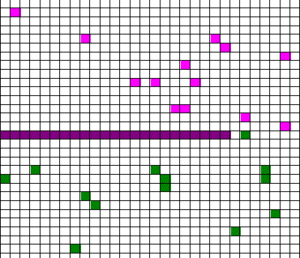
Brownian motion is the mathematical model used to describe the random movement of particles suspended in a fluid. The gas particle animation, using pink and green particles, illustrates how this behavior results in the spreading out of gases (entropy). These events are also described by particle theory.
Since it is at the limit of (or beyond) current technology to observe individual gas particles (atoms or molecules), only theoretical calculations give suggestions about how they move, but their motion is different from Brownian motion because Brownian motion involves a smooth drag due to the frictional force of many gas molecules, punctuated by violent collisions of an individual (or several) gas molecule(s) with the particle. The particle (generally consisting of millions or billions of atoms) thus moves in a jagged course, yet not so jagged as would be expected if an individual gas molecule were examined.
القوى البينجزيئية
As discussed earlier, momentary attractions (or repulsions) between particles have an effect on gas dynamics. In physical chemistry, the name given to these intermolecular forces is van der Waals force. These forces play a key role in determining physical properties of a gas such as viscosity and flow rate (see physical characteristics section). Ignoring these forces in certain conditions allows a real gas to be treated like an ideal gas. This assumption allows the use of ideal gas laws which greatly simplifies calculations.
Proper use of these gas relationships requires the kinetic-molecular theory (KMT). When gas particles experience intermolecular forces they gradually influence one another as the spacing between them is reduced (the hydrogen bond model illustrates one example). In the absence of any charge, at some point when the spacing between gas particles is greatly reduced they can no longer avoid collisions between themselves at normal gas temperatures. Another case for increased collisions among gas particles would include a fixed volume of gas, which upon heating would contain very fast particles. This means that these ideal equations provide reasonable results except for extremely high pressure (compressible) or high temperature (ionized) conditions. All of these excepted conditions allow energy transfer to take place within the gas system. The absence of these internal transfers is what is referred to as ideal conditions in which the energy exchange occurs only at the boundaries of the system. Real gases experience some of these collisions and intermolecular forces. When these collisions are statistically negligible (incompressible), results from these ideal equations are still meaningful. If the gas particles are compressed into close proximity they behave more like a liquid (see fluid dynamics).
النماذج المبسطة
An equation of state (for gases) is a mathematical model used to roughly describe or predict the state properties of a gas. At present, there is no single equation of state that accurately predicts the properties of all gases under all conditions. Therefore, a number of much more accurate equations of state have been developed for gases in specific temperature and pressure ranges. The "gas models" that are most widely discussed are "perfect gas", "ideal gas" and "real gas". Each of these models has its own set of assumptions to facilitate the analysis of a given thermodynamic system.[13] Each successive model expands the temperature range of coverage to which it applies.
نماذج الغاز المثالي والغاز الأفضل
The equation of state for an ideal or perfect gas is the ideal gas law and reads
where P is the pressure, V is the volume, n is amount of gas (in mol units), R is the universal gas constant, 8.314 J/(mol K), and T is the temperature. Written this way, it is sometimes called the "chemist's version", since it emphasizes the number of molecules n. It can also be written as
where is the specific gas constant for a particular gas, in units J/(kg K), and ρ = m/V is density. This notation is the "gas dynamicist's" version, which is more practical in modeling of gas flows involving acceleration without chemical reactions.
The ideal gas law does not make an assumption about the specific heat of a gas. In the most general case, the specific heat is a function of both temperature and pressure. If the pressure-dependence is neglected (and possibly the temperature-dependence as well) in a particular application, sometimes the gas is said to be a perfect gas, although the exact assumptions may vary depending on the author and/or field of science.
For an ideal gas, the ideal gas law applies without restrictions on the specific heat. An ideal gas is a simplified "real gas" with the assumption that the compressibility factor Z is set to 1 meaning that this pneumatic ratio remains constant. A compressibility factor of one also requires the four state variables to follow the ideal gas law.
This approximation is more suitable for applications in engineering although simpler models can be used to produce a "ball-park" range as to where the real solution should lie. An example where the "ideal gas approximation" would be suitable would be inside a combustion chamber of a jet engine.[14] It may also be useful to keep the elementary reactions and chemical dissociations for calculating emissions.
الغاز الحقيقي
Each one of the assumptions listed below adds to the complexity of the problem's solution. As the density of a gas increases with rising pressure, the intermolecular forces play a more substantial role in gas behavior which results in the ideal gas law no longer providing "reasonable" results. At the upper end of the engine temperature ranges (e.g. combustor sections – 1300 K), the complex fuel particles absorb internal energy by means of rotations and vibrations that cause their specific heats to vary from those of diatomic molecules and noble gases. At more than double that temperature, electronic excitation and dissociation of the gas particles begins to occur causing the pressure to adjust to a greater number of particles (transition from gas to plasma).[15] Finally, all of the thermodynamic processes were presumed to describe uniform gases whose velocities varied according to a fixed distribution. Using a non-equilibrium situation implies the flow field must be characterized in some manner to enable a solution. One of the first attempts to expand the boundaries of the ideal gas law was to include coverage for different thermodynamic processes by adjusting the equation to read pVn = constant and then varying the n through different values such as the specific heat ratio, γ.
Real gas effects include those adjustments made to account for a greater range of gas behavior:
- Compressibility effects (Z allowed to vary from 1.0)
- Variable heat capacity (specific heats vary with temperature)
- Van der Waals forces (related to compressibility, can substitute other equations of state)
- Non-equilibrium thermodynamic effects
- Issues with molecular dissociation and elementary reactions with variable composition.
For most applications, such a detailed analysis is excessive. Examples where real gas effects would have a significant impact would be on the Space Shuttle re-entry where extremely high temperatures and pressures were present or the gases produced during geological events as in the image of the 1990 eruption of Mount Redoubt.
الغازات الكاملة
إن الغازات المعروفة تحقق القوانين البسيطة للانضغاط والتمدد: أمثال قانوني ماريوت وگاي ـ لوساك وقانون أفوگادرو، ولكن بصورة تقريبية.
مزيج الغازات
تنتشر الغازات بعضها في بعض، ويكون المزيج في النهاية متجانساً دائماً. وقد بيّنت تجربة بيرتوليه Berthollet، أن مزج غازين مثل H2 وCO2 في درجة حرارة وحجم كلي ثابتين، لا يؤدي إلى أي تغير في الضغط. ويعرَّف الضغط الجزئي لغاز في مزيج، أنه ضغط الغاز فيما لو شغل الحجم الكلي للمزيج وحده، وذلك في درجة الحرارة نفسها. إذا افترض إمكانية تطبيق قانون ماريوت على كل غاز، فعندئذٍ يكون : P1(V1+V2)=PV1 وp2(v1+v2)=pv2 ، حيث يرمز P1 وP2 إلى الضغطين الجزئيين وP إلى الضغط الكلي، ومنه P1+P2= P. أي إن الضغط الكلي لمزيج يساوي مجموع الضغوط الجزئية، هذا هو قانون دالتون Dalton. وفي الواقع، لايتبع غاز حقيقي قانون ماريوت بدقة، ويلاحظ دائماً في حالة المزيج ابتعاد عن قانون دالتون، وهو غير دقيق إلاّ في حالة مزيج غازات كاملة.
النظرية الحركية للغازات
أسس هذه النظرية دانيال برنولي Daniel Bernoulli عام 1730، وفصَّل فيها ماكسويل Maxwell وكلاوزيوس Clausius، وأسهم في تطويرها علماء آخرون كثيرون. تتشكل الغازات وفق هذه النظرية، من جزيئات عديدة جداً تتحرك حركةً دائمةً سريعةً وعشوائية، وتتغير اتجاهاتها باستمرار نتيجة الاصطدامات فيما بينها ومع الجدران، وهذه الاصطدامات الأخيرة هي التي تولّد ضغط الغاز. لا يوجد في هذه النظرة أي تأثير متبادل بين الجزيئات إلا من خلال تصادمها، وتعد الاصطدامات كلها مرنة تماماً، مما يسمح لحركة الجزيئات بالاستمرار إلى ما لا نهاية دون أن تتطلب طاقة خارجية، وهذا ما يتضح مباشرة من مراقبة الحركة البراونية في الغازات.
تتوزع سرعات الجزيئات في كل لحظة، من حيث الطويلة والمَنْحى، وفق القانون الذي وجده ماكسويل، وهو يماثل قانون أخطاء غاوس (قانون الأعداد الكبيرة)، والذي يُعبر عنه بمنحنٍ على شكل جرس، الشكل (2). مع ذلك، فمن المستحيل التنبؤ بحركة كل جزيئة. إن إحدى خصائص النظرية الحركية للغازات هي إنها تأخذ في الحسبان القيم الوسطية للمقادير المختلفة، مثل السرعة أو الطاقة الحركية للجزيئات. ويوافق التوزع الذي يعطيه قانون ماكسويل، سرعة وسطية وسرعة تربيعية وسطية تختلف عن السابقة (ولو أنها قريبة منها)، وتعرَّف أن مربعها يساوي وسطي مربع السرعات. وتعطي النظرية الحركية تفسيراً لضغط الغاز ولدرجة حرارته؛ وتؤدي إلى معادلة حالة الغاز، مع بعض الفرضيات على التأثيرات المتبادلة بين الجزيئات، كما أنها تعطي تفسيراً للزوجة الغاز وتتنبأ باستقلال هذه اللزوجة عن الضغط، وهذا ما تؤكده التجربة. وتسمح بحساب الناقلية الحرارية النوعية للغاز.[16]
الأبحاث التاريخية
قانون بويل
Boyle's law was perhaps the first expression of an equation of state. In 1662 Robert Boyle performed a series of experiments employing a J-shaped glass tube, which was sealed on one end. Mercury was added to the tube, trapping a fixed quantity of air in the short, sealed end of the tube. Then the volume of gas was carefully measured as additional mercury was added to the tube. The pressure of the gas could be determined by the difference between the mercury level in the short end of the tube and that in the long, open end. The image of Boyle's equipment shows some of the exotic tools used by Boyle during his study of gases.
Through these experiments, Boyle noted that the pressure exerted by a gas held at a constant temperature varies inversely with the volume of the gas.[17] For example, if the volume is halved, the pressure is doubled; and if the volume is doubled, the pressure is halved. Given the inverse relationship between pressure and volume, the product of pressure (P) and volume (V) is a constant (k) for a given mass of confined gas as long as the temperature is constant. Stated as a formula, thus is:
Because the before and after volumes and pressures of the fixed amount of gas, where the before and after temperatures are the same both equal the constant k, they can be related by the equation:
قانون شارل
In 1787, the French physicist and balloon pioneer, Jacques Charles, found that oxygen, nitrogen, hydrogen, carbon dioxide, and air expand to the same extent over the same 80 kelvin interval. He noted that, for an ideal gas at constant pressure, the volume is directly proportional to its temperature:
قانون گاي-لوساك
In 1802, Joseph Louis Gay-Lussac published results of similar, though more extensive experiments.[18] Gay-Lussac credited Charles' earlier work by naming the law in his honor. Gay-Lussac himself is credited with the law describing pressure, which he found in 1809. It states that the pressure exerted on a container's sides by an ideal gas is proportional to its temperature.
قانون أڤوگادرو
In 1811, Amedeo Avogadro verified that equal volumes of pure gases contain the same number of particles. His theory was not generally accepted until 1858 when another Italian chemist Stanislao Cannizzaro was able to explain non-ideal exceptions. For his work with gases a century prior, the number that bears his name Avogadro's constant represents the number of atoms found in 12 grams of elemental carbon-12 (6.022×1023 mol−1). This specific number of gas particles, at standard temperature and pressure (ideal gas law) occupies 22.40 liters, which is referred to as the molar volume.
Avogadro's law states that the volume occupied by an ideal gas is proportional to the number of moles (or molecules) present in the container. This gives rise to the molar volume of a gas, which at STP is 22.4 dm3 (or litres). The relation is given by
where n is equal to the number of moles of gas (the number of molecules divided by Avogadro's number).
قانون دالتون
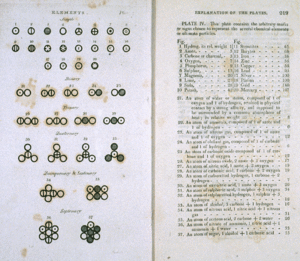
In 1801, John Dalton published the law of partial pressures from his work with ideal gas law relationship: The pressure of a mixture of non reactive gases is equal to the sum of the pressures of all of the constituent gases alone. Mathematically, this can be represented for n species as:
- Pressuretotal = Pressure1 + Pressure2 + ... + Pressuren
The image of Dalton's journal depicts symbology he used as shorthand to record the path he followed. Among his key journal observations upon mixing unreactive "elastic fluids" (gases) were the following:[19]
- Unlike liquids, heavier gases did not drift to the bottom upon mixing.
- Gas particle identity played no role in determining final pressure (they behaved as if their size was negligible).
مواضيع خاصة
قابلية الانضغاط
Thermodynamicists use this factor (Z) to alter the ideal gas equation to account for compressibility effects of real gases. This factor represents the ratio of actual to ideal specific volumes. It is sometimes referred to as a "fudge-factor" or correction to expand the useful range of the ideal gas law for design purposes. Usually this Z value is very close to unity. The compressibility factor image illustrates how Z varies over a range of very cold temperatures.
رقم رينولدز
In fluid mechanics, the Reynolds number is the ratio of inertial forces (vsρ) to viscous forces (μ/L). It is one of the most important dimensionless numbers in fluid dynamics and is used, usually along with other dimensionless numbers, to provide a criterion for determining dynamic similitude. As such, the Reynolds number provides the link between modeling results (design) and the full-scale actual conditions. It can also be used to characterize the flow.
اللزوجة
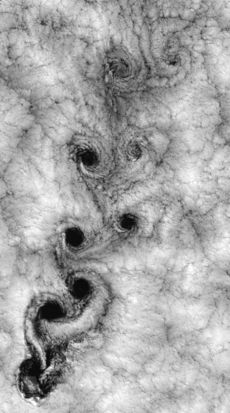
Viscosity, a physical property, is a measure of how well adjacent molecules stick to one another. A solid can withstand a shearing force due to the strength of these sticky intermolecular forces. A fluid will continuously deform when subjected to a similar load. While a gas has a lower value of viscosity than a liquid, it is still an observable property. If gases had no viscosity, then they would not stick to the surface of a wing and form a boundary layer. A study of the delta wing in the Schlieren image reveals that the gas particles stick to one another (انظر قسم الطبقة الحدية).
اضطراب
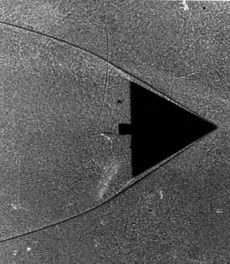
In fluid dynamics, turbulence or turbulent flow is a flow regime characterized by chaotic, stochastic property changes. This includes low momentum diffusion, high momentum convection, and rapid variation of pressure and velocity in space and time. The satellite view of weather around Robinson Crusoe Islands illustrates one example.
الطبقة الحدية
Particles will, in effect, "stick" to the surface of an object moving through it. This layer of particles is called the boundary layer. At the surface of the object, it is essentially static due to the friction of the surface. The object, with its boundary layer is effectively the new shape of the object that the rest of the molecules "see" as the object approaches. This boundary layer can separate from the surface, essentially creating a new surface and completely changing the flow path. The classical example of this is a stalling airfoil. The delta wing image clearly shows the boundary layer thickening as the gas flows from right to left along the leading edge.
مبدأ الإنتروپية القصوى
As the total number of degrees of freedom approaches infinity, the system will be found in the macrostate that corresponds to the highest multiplicity. In order to illustrate this principle, observe the skin temperature of a frozen metal bar. Using a thermal image of the skin temperature, note the temperature distribution on the surface. This initial observation of temperature represents a "microstate". At some future time, a second observation of the skin temperature produces a second microstate. By continuing this observation process, it is possible to produce a series of microstates that illustrate the thermal history of the bar's surface. Characterization of this historical series of microstates is possible by choosing the macrostate that successfully classifies them all into a single grouping.
التوازن الثرموديناميكي
When energy transfer ceases from a system, this condition is referred to as thermodynamic equilibrium. Usually, this condition implies the system and surroundings are at the same temperature so that heat no longer transfers between them. It also implies that external forces are balanced (volume does not change), and all chemical reactions within the system are complete. The timeline varies for these events depending on the system in question. A container of ice allowed to melt at room temperature takes hours, while in semiconductors the heat transfer that occurs in the device transition from an on to off state could be on the order of a few nanoseconds.
انظر أيضا
قالب:Table of phase transitions
الهامش
- ^ This early 20th century discussion infers what is regarded as the plasma state. See page 137 of American Chemical Society, Faraday Society, Chemical Society (Great Britain) The Journal of Physical Chemistry, Volume 11 Cornell (1907).
- ^ The work by T. Zelevinski provides another link to recent research about strontium in this new field of study. See Tanya Zelevinsky (2009). "84Sr—just right for forming a Bose-Einstein condensate". Physics. 2: 94. Bibcode:2009PhyOJ...2...94Z. doi:10.1103/physics.2.94.
- ^ For the Bose–Einstein condensate see Quantum Gas Microscope Offers Glimpse Of Quirky Ultracold Atoms. ScienceDaily. 4 November 2009.
- ^ J. B. van Helmont, Ortus medicinae. … (Amsterdam, (Netherlands): Louis Elzevir, 1652 (first edition: 1648)). The word "gas" first appears on page 58, where he mentions: "… Gas (meum scil. inventum) …" (… gas (namely, my discovery) …). On page 59, he states: "… in nominis egestate, halitum illum, Gas vocavi, non longe a Chao …" (… in need of a name, I called this vapor "gas", not far from "chaos" …)
- ^ Ley, Willy (June 1966). "The Re-Designed Solar System". For Your Information. Galaxy Science Fiction. pp. 94–106.
- ^ قالب:OEtymD
- ^ Draper, John William (1861). A textbook on chemistry. New York: Harper and Sons. p. 178.
- ^ Barzun, Jacques (2000). For Dawn to Decadence: 500 Years of Western Cultural Life. New York: HarperCollins Publishers. p. 199.
- ^ Anderson, p.501
- ^ See pages 137–8 of Society, Cornell (1907).
- ^ Kenneth Wark (1977). Thermodynamics (3 ed.). McGraw-Hill. p. 12. ISBN 978-0-07-068280-1.
- ^ For assumptions of kinetic theory see McPherson, pp.60–61
- ^ Anderson, pp. 289–291
- ^ John, p.205
- ^ John, pp. 247–56
- ^ خالد المصري. "الغاز". الموسوعة العربية.
- ^ McPherson, pp.52–55
- ^ McPherson, pp.55–60
- ^ John P. Millington (1906). John Dalton. pp. 72, 77–78.
المصادر
- John D. Anderson. Modern Compressible Flow: Third Edition New York, NY : McGraw-Hill, 2004. ISBN 007-124136-1
- Philip Hill and Carl Peterson. Mechanics and Thermodynamics of Propulsion: Second Edition Addison-Wesley, 1992. ISBN 0-201-14659-2
- John D. Anderson. Fundamentals of Aerodynamics: Fourth Edition New York, NY : McGraw-Hill, 2007. ISBN 978-0-07-295046-5 ISBN 0-07-295046-3
- National Aeronautics and Space Administration (NASA). Animated Gas Lab. Accessed February, 2008.
- Georgia State University. HyperPhysics. Accessed February, 2008.
- Antony Lewis WordWeb. Accessed February, 2008.
- Northwestern Michigan College The Gaseous State. Accessed February, 2008.


